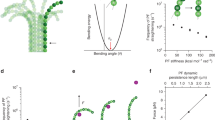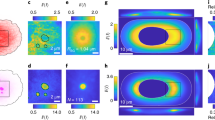Abstract
MICROTUBULES are believed to be the principal organizers of the cell interior1. Cells respond to a variety of stimuli by modifying the spatial distribution of the microtubules. These effects are central to cell division and morphogenesis2, and embryo development3. During embryo development, macroscopic patterns are frequently observed3. Here we report that microtubular solutions spontaneously form alternating white and dark stripes about 1 mm wide and 1 cm long. Small-angle neutron scattering measurements show that in each segment the microtubules are aligned obliquely to the direction of the stripe, and that the white and dark stripes differ in having mutually orthogonal orientations. The formation of these structures requires an initial reservoir of organic phosphate. Phosphorus NMR measurements show that the process is accompanied by the energy-liberating conversion of organic to inorganic phosphate. These observations, together with similarities to the dissipative spatial structure formed by the Belousov–Zhabotinski reaction4–6, provide strong evidence that the observed structures are energy-dissipative in nature. Dissipative structures are thought to be critical to the appearence of complex living organisms7,8. Our results strongly suggest that microtubules are capable of forming such structures. Microtubular dissipative structures may occur during mitosis and embryo morphogenesis.
This is a preview of subscription content, access via your institution
Access options
Subscribe to this journal
Receive 51 print issues and online access
$199.00 per year
only $3.90 per issue
Buy this article
- Purchase on Springer Link
- Instant access to full article PDF
Prices may be subject to local taxes which are calculated during checkout
Similar content being viewed by others
References
Alberts, B. et al. Molecular Biology of the Cell (Garland, New York, 1983).
Kirschner, M. & Mitchison, T. Cell 45, 329–342 (1986).
Davidson, E. H. Gene Activity in Early Development (Academic, London, 1986).
Tyson, J. J. The Belousov-Zhabotinski Reaction, Lecture Notes in Biophysics (Springer, Berlin, 1976).
Field, R. J. & Burger, M. (eds) Oscillations and Travelling Waves in Chemical Systems (Wiley, New York, 1985).
Glansdorff, P. & Prigogine, I. Thermodynamic Theory of Structure, Stability and Fluctuations (Wiley-lnterscience, New York, 1971).
Nicolis, G. & Prigogine, I. Self Organisation in Nonequilibrium Systems (Wiley-lntersciences, New York, 1977).
Prigogine, I. & Stengers, I. Order Out of Chaos (Heinemann, London, 1984).
Job, D., Pabion, M. & Margolis, R. J. Cell. Biol. 101, 1680–1689 (1985).
Jacrot, B. Rep. Prog. Phys. 39, 911–953 (1976).
Bordas, J., Mandelkow, E. M. & Mandelkow, E. J. molec. Biol. 164, 89–135 (1983).
Federov, B. et al. FEBS Lett. 84, 153–155 (1977).
Onsager, L. Ann. N.Y. Acad. Sci. 51, 627–659 (1949).
Haken, H. Synergetics (Springer. Berlin, 1978).
Vidal, Ch. La Recherche 20, 1476–1485 (1989).
Bergé, P., Pomean, Y. & Vidal, Ch. Order Within Chaos (Wiley, New York. 1987).
Murray, J. D. Mathematical Biology (Springer, Berlin, 1989).
Turing, A. M. Phil. Trans. R. Soc. B237, 37–72 (1952).
de Gennes, P. G. The Physics of Liquid Crystals (Clarendon, Oxford, 1974).
Miike, H., Ochiai, K., Hashimoto, H. & Ebina, Y. J. phys. Soc. Jap. 54, 1724–1729 (1985).
Pirollet, F., Job, D., Margolis, R. & Garel, J. R. EMBO J. 6, 3247–3252 (1987).
Carlier, M. F., Melki, R., Pantaloni, D., Hill, T. L. & Chen, Y. Proc. natn. Acad. Sci. U.S.A. 84, 5257–5262 (1987)
Mandelkow, E. M., Lange, G., Jagla, A., Spann, U. & Mandelkow, E. EMBO J. 7, 357–365 (1988).
Dustin, P. Microtubules (Springer, Berlin, 1984).
Carlier, M. F. & Pantaloni, D. Biochemistry 20, 1918–1924 (1981).
Wilson, L., Snyder, K. B., Thompson, W. C. & Margolis, R. L. Meth. Cell Biol. A24, 159–169 (1982).
Lonberg, F., Fraden, S., Hurd, A. & Meyer, R. Phys. Rev. Lett. 52, 1903–1906 (1984).
Mandelkow, E., Mandelkow, E. M., Hotari, E. M., Hess, B. & Muller, S. Science 246, 1291–1293 (1989).
Hitt, A., Cross, A. & Williams, R. J. biol. Chem. 265, 1639–1647 (1990).
Rebhun, L. I. & Sander, G. J. Cell. Biol. 34, 859–884 (1967).
Handbook of Neutron-beam Facilities Available for Users (Institut Laue-Langevin, Grenoble, 1981).
Author information
Authors and Affiliations
Rights and permissions
About this article
Cite this article
Tabony, J., Job, D. Spatial structures in microtubular solutions requiring a sustained energy source. Nature 346, 448–451 (1990). https://doi.org/10.1038/346448a0
Received:
Accepted:
Issue Date:
DOI: https://doi.org/10.1038/346448a0
This article is cited by
-
Changes in interstitial fluid flow, mass transport and the bone cell response in microgravity and normogravity
Bone Research (2022)
-
The E. coli MinCDE system in the regulation of protein patterns and gradients
Cellular and Molecular Life Sciences (2019)
-
Gravity sensing by cells: mechanisms and theoretical grounds
Rendiconti Lincei (2014)
-
On the Nature and Shape of Tubulin Trails: Implications on Microtubule Self-Organization
Acta Biotheoretica (2012)
-
Life Began When Evolution Began: A Lipidic Vesicle-Based Scenario
Origins of Life and Evolution of Biospheres (2009)
Comments
By submitting a comment you agree to abide by our Terms and Community Guidelines. If you find something abusive or that does not comply with our terms or guidelines please flag it as inappropriate.



